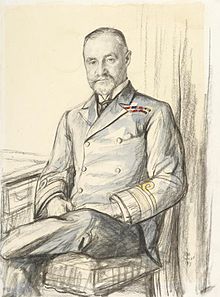Richard Phillimore
Sir Richard Phillimore | |
|---|---|
 1917 portrait by Francis Dodd | |
| Born | 23 December 1864 Boconnoc, Cornwall |
| Died | 8 November 1940 (aged 75) Botley, Hampshire |
| Allegiance | |
| Service/ | |
| Years of service | 1878–1929 |
| Rank | Admiral |
| Commands held | HMS Mohawk HMS Juno HMS Aboukir HMS Inflexible 2nd Battle Cruiser Squadron 1st Battle Cruiser Squadron Reserve Fleet Plymouth Command |
| Battles/wars | Boxer Rebellion World War I |
| Awards | Knight Grand Cross of the Order of the Bath Knight Commander of the Order of St Michael and St George Member of the Royal Victorian Order |
Admiral Sir Richard Fortescue Phillimore GCB KCMG MVO (23 December 1864 – 8 November 1940) was a Royal Navy officer who went on to be Commander-in-Chief, Plymouth.
[]
Phillimore was born at Boconnoc in Cornwall, the son of Admiral Sir Augustus Phillimore, and educated at Westminster School.[1] He joined the Royal Navy in 1878,[2] was promoted to lieutenant on 20 August 1886,[3] and to commander on 1 January 1899.[4] He was posted to HMS Goliath on 27 March 1900,[5] her first commission, and joined her to the China Station where she took part in the response to the Boxer Rebellion later in 1900.[1] He was given command of HMS Mohawk in 1903 and then led the Naval Brigade Machine Guns in Somaliland the next year.[2] He was then given command of HMS Juno in 1907, HMS Aboukir in 1909 and the battlecruiser HMS Inflexible in 1911.[2]
He served in World War I as Commander of the 2nd Battle Cruiser Squadron and then as Principal Beach Master for the landings at Cape Helles in the Dardanelles in April 1915.[2] He went on to be liaison officer to the Imperial Russian Headquarters in 1915 and Commander of the 1st Battle Cruiser Squadron of the Grand Fleet in 1916.[2] He was then made Admiral commanding the Aircraft of the Grand Fleet in 1917[2] and took part in Second Battle of Heligoland Bight in November 1917.[1]
After the war, he was appointed President of the Postwar Questions Committee and then commanded the Reserve Fleet from 1920.[2] He was made Commander-in-Chief, Plymouth in 1923.[1] He was First and Principal Naval Aide-de-Camp to King George V from 1928[1] and retired in 1929.[2]
He is buried at Shedfield in Hampshire.[1]
Family[]
In 1905 he married Violet Turton; they had three sons and one daughter.[1]
References[]
- ^ Jump up to: a b c d e f g "Phillimore, Sir Richard Fortescue". Oxford Dictionary of National Biography (online ed.). Oxford University Press. 5 January 2012. doi:10.1093/ref:odnb/35510. (Subscription or UK public library membership required.)
- ^ Jump up to: a b c d e f g h Liddell Hart Centre for Military Archives
- ^ "No. 25620". The London Gazette. 27 August 1886. p. 4176.
- ^ "No. 27040". The London Gazette. 6 January 1899. p. 84.
- ^ "Naval & Military intelligence". The Times (36083). London. 7 March 1900. p. 10.
External links[]
- The Dreadnought Project: Richard Phillimore
- 1864 births
- 1940 deaths
- People educated at Westminster School, London
- Royal Navy admirals of World War I
- Knights Grand Cross of the Order of the Bath
- Knights Commander of the Order of St Michael and St George
- Members of the Royal Victorian Order
- People from Cornwall
- People from Botley, Hampshire
